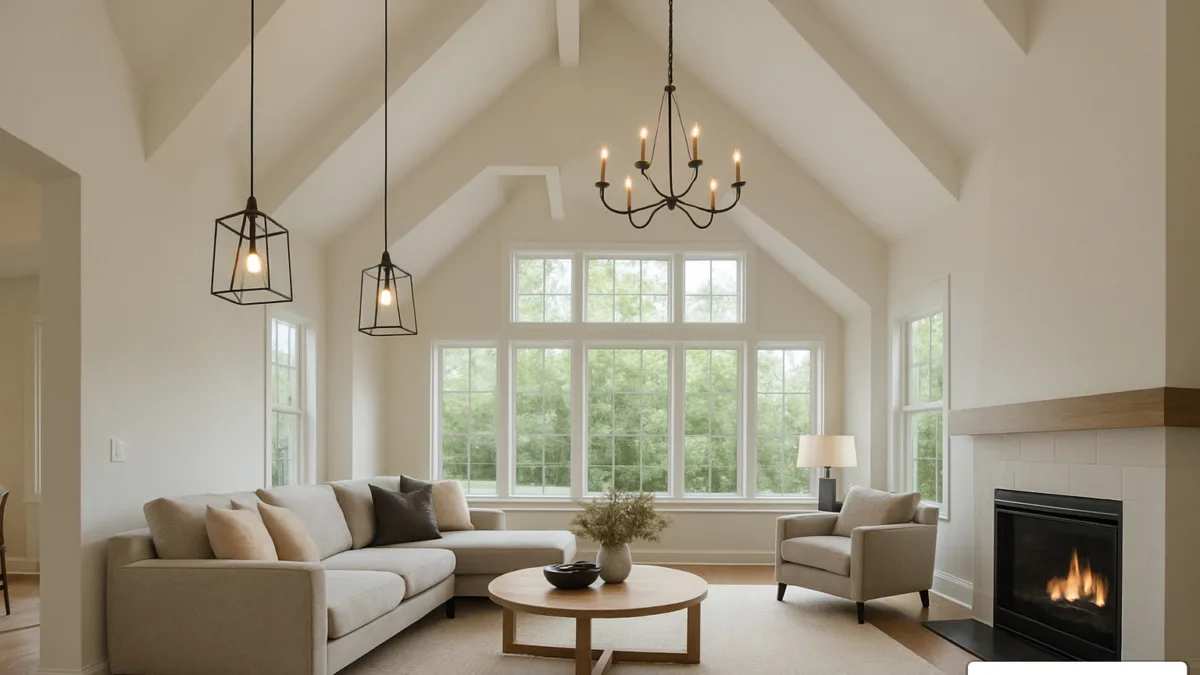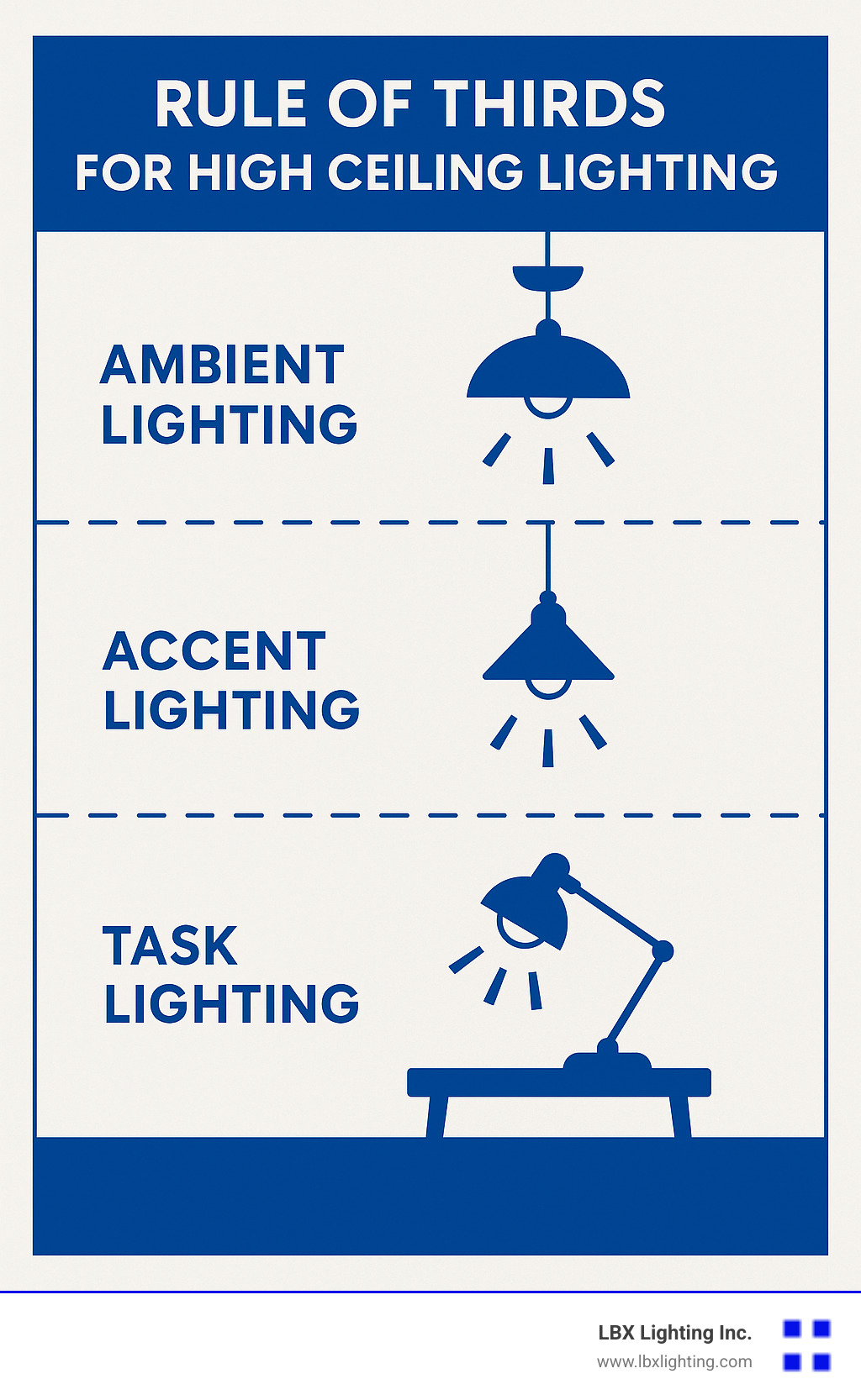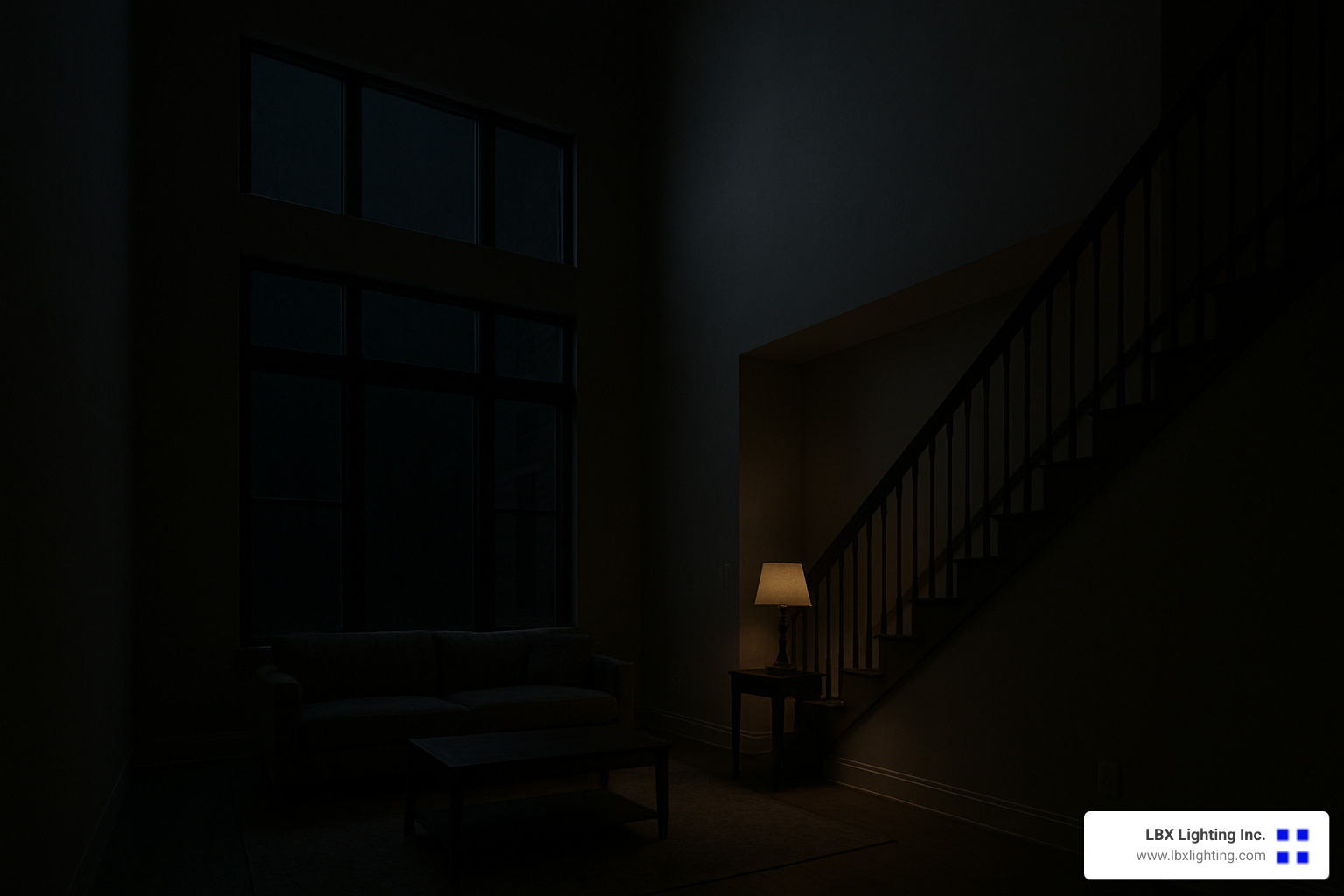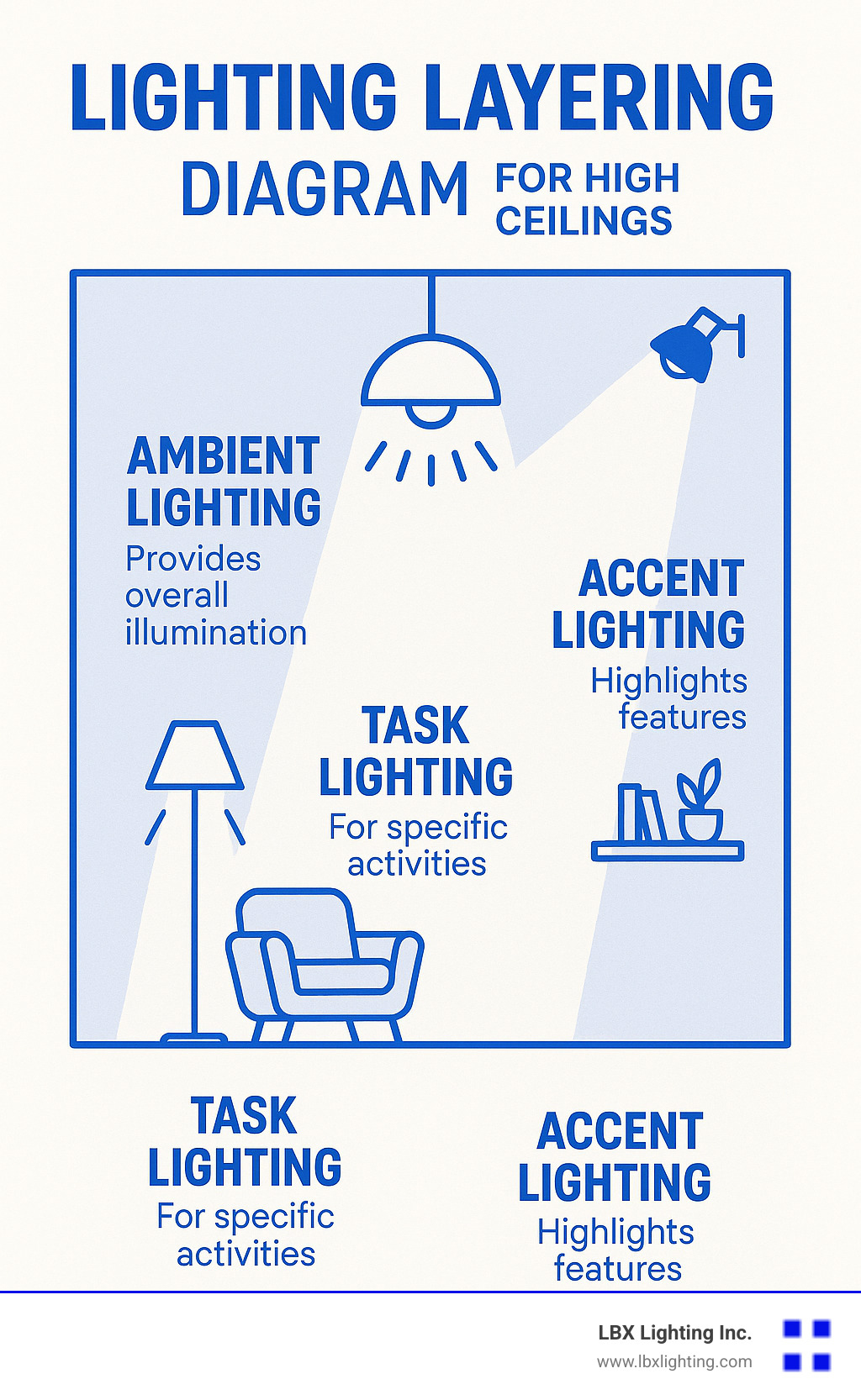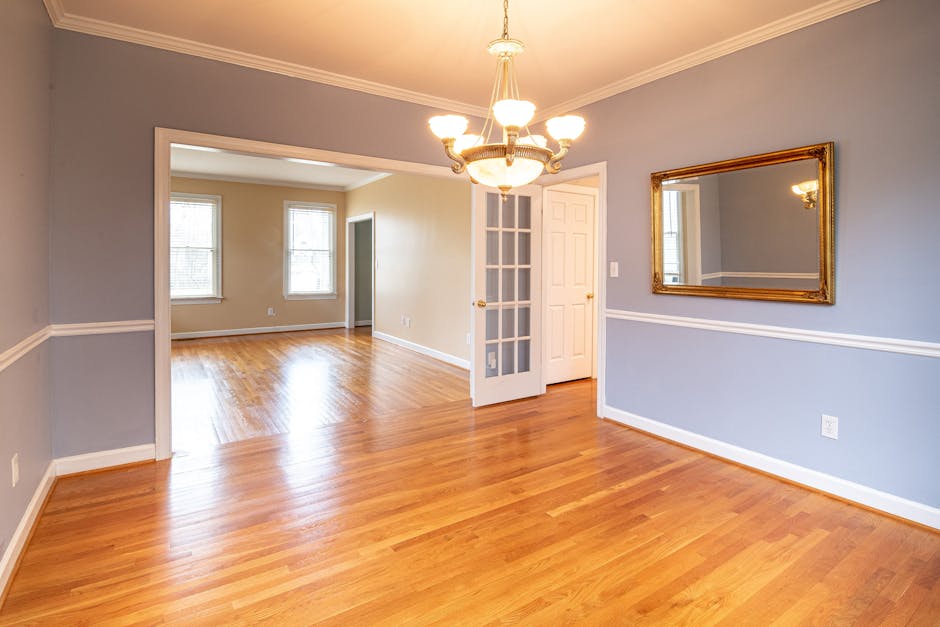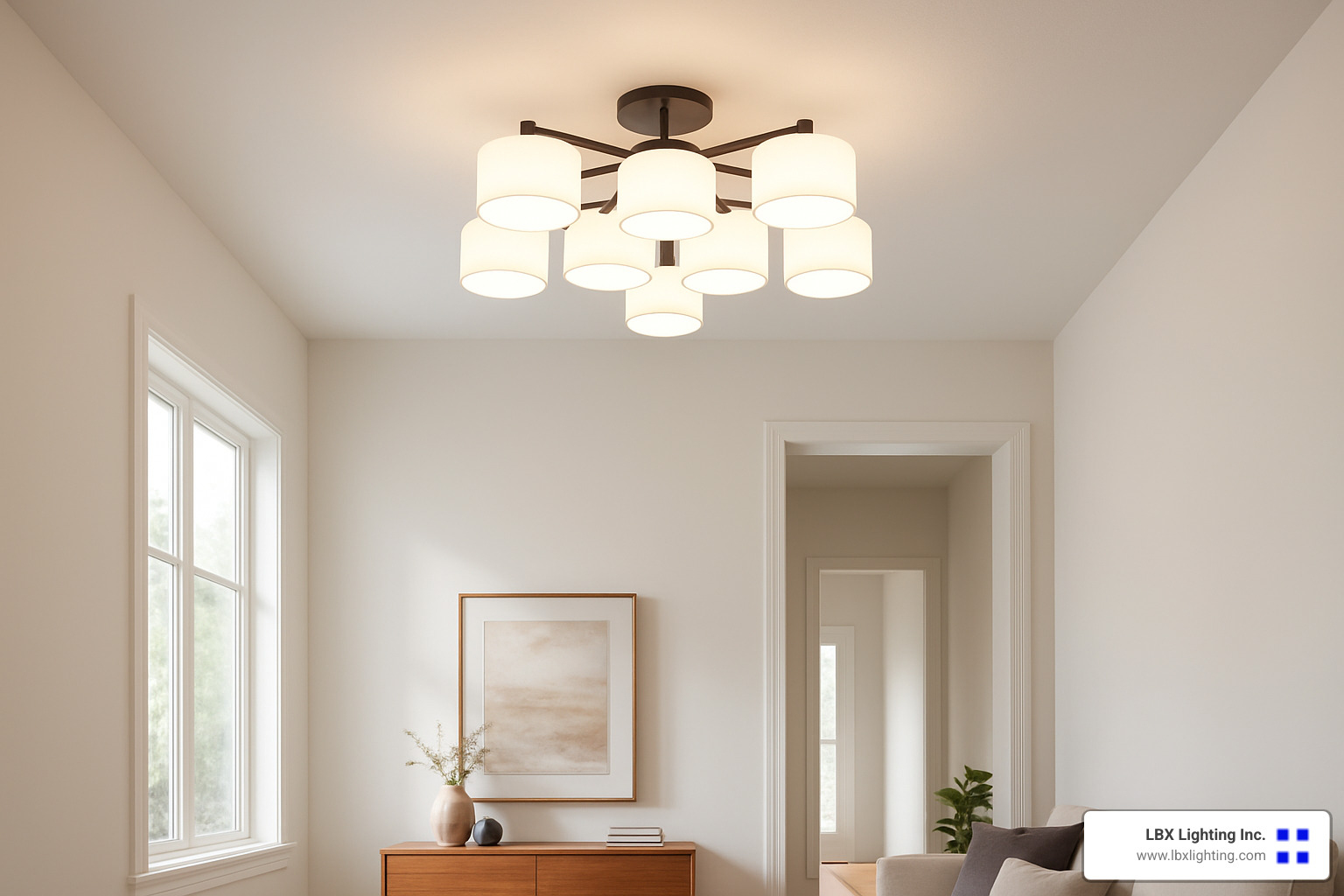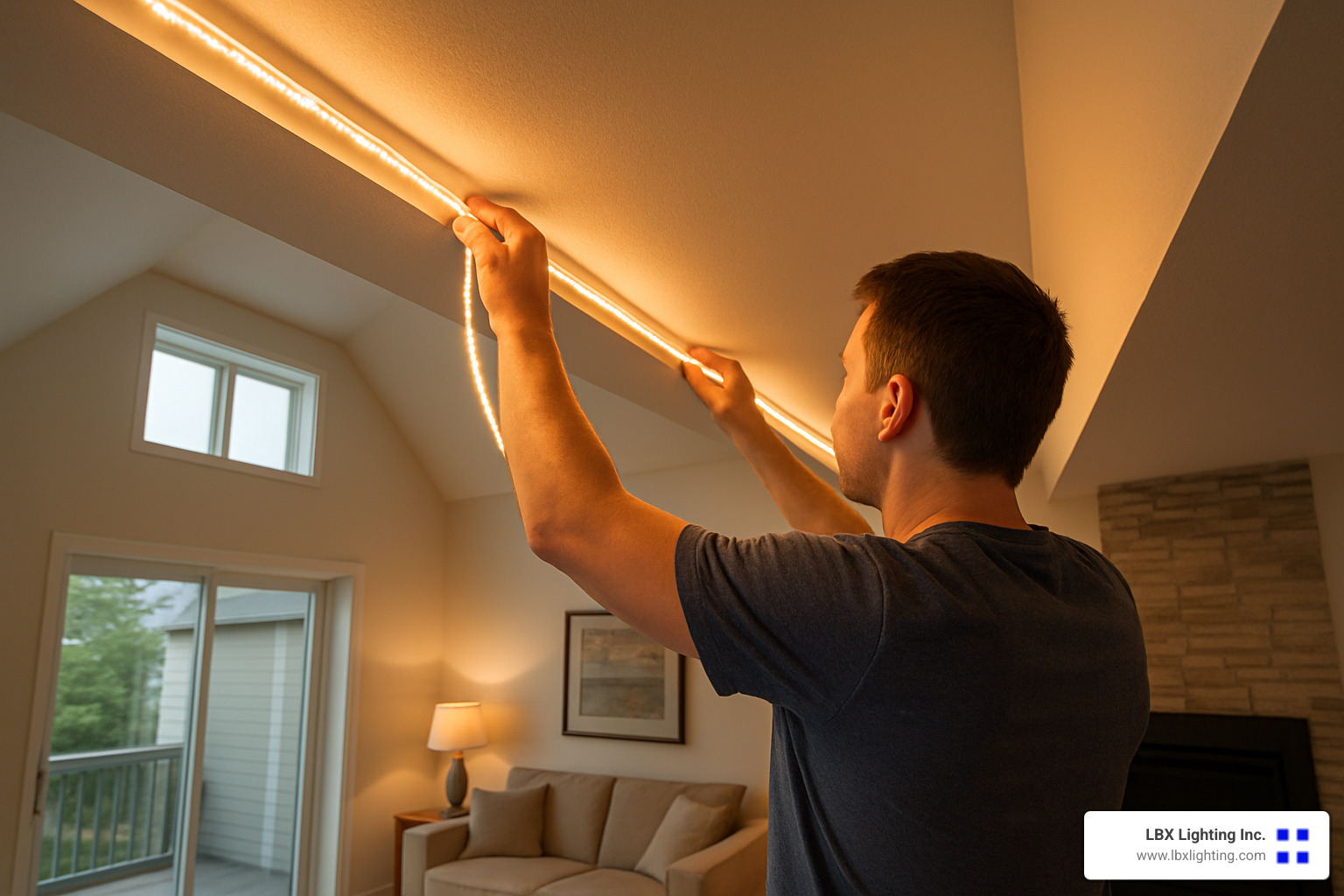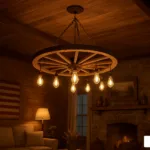
Rustic Radiance: Your Guide to Wagon Wheel Light Fixtures
May 2, 2025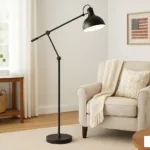
Flex Your Style: The Ultimate Guide to Adjustable Floor Lamps
May 6, 2025Illuminating the Heights: Best Lighting Options for Tall Ceilings
What is the best lighting for high ceilings depends on your specific space and needs. Here’s a quick answer:
| Best Lighting for High Ceilings | Why It Works |
|---|---|
| Chandeliers & Large Pendants | Create focal points and fill vertical space |
| Recessed Lighting with Narrow Beams | Provides focused downlighting without visual clutter |
| Multi-tiered Lighting (ambient, task, accent) | Ensures complete illumination at all levels |
| LED High Bay Fixtures | Ideal for very tall commercial/industrial spaces |
| Wall Sconces & Uplighting | Highlights architectural features and adds dimension |
What is the best lighting for high ceilings presents unique challenges and exciting design opportunities. Rooms with soaring ceilings require thoughtful lighting strategies that address both functionality and aesthetics. Without proper illumination, these grand spaces can feel cavernous and unwelcoming rather than impressive and inviting.
Most people with high-ceilinged spaces struggle with even light distribution and creating a sense of warmth. The sheer volume demands more lumens—approximately 5% more for each foot above 10 feet—and careful placement to avoid dark zones and harsh shadows.
As interior designer Victoria Holly notes, “For spaces with high ceilings, first and foremost, lighting is your friend. Incorporate statement lighting such as large chandeliers or sculptural pendant lights.” This expert insight highlights the dual purpose of fixtures in tall rooms: they must both illuminate effectively and serve as visual anchors that draw the eye upward.
I’m Michael Eftekhar, and with over 30 years of experience at LBX Lighting, I’ve helped countless Houston homeowners and designers solve what is the best lighting for high ceilings challenges through layered lighting approaches that combine dramatic statement pieces with practical illumination solutions.
Basic what is the best lighting for high ceilings glossary:
– chandeliers for tall foyers
– flush mount ceiling lights
Why High Ceilings Need a Different Lighting Game Plan
When it comes to lighting spaces with high ceilings, the standard playbook simply doesn’t work. That gorgeous volume of space that makes your room feel so grand? It’s also creating unique lighting challenges that require thoughtful solutions.
Think about how light behaves in your space. Light naturally fades as it travels (this is called the inverse square law). In a room with 18-foot ceilings versus standard 8-foot ceilings, your light has to journey more than twice as far to reach your furniture, artwork, and—most importantly—you! Without proper planning, even the most beautiful vaulted space can end up feeling like a dim, shadowy cave rather than the showstopper it should be.
“Most people long for a house with high ceilings for their elegance and spaciousness,” explains lighting designer Leigh Spicher, “but without proper lighting, these impressive architectural features can make a room feel cold and cavernous rather than grand and welcoming.”
Here at LBX Lighting in Houston, we’ve helped countless homeowners transform their challenging tall spaces from gloomy to glorious with the right lighting approach.
Unique Lighting Challenges Presented by High Ceilings
Your soaring ceilings create several specific lighting problems that standard rooms don’t face:
Beam spread limitations become immediately apparent in tall spaces. Those standard downlights that work perfectly in your 8-foot ceiling bathroom? At 18 feet up, their light cone narrows dramatically, creating spotlighting rather than even illumination.
Brightness drop-off is a real concern. That beautiful light from your fixture gets significantly dimmer with every foot it travels. For practical purposes, you’ll need about 5% more lumens for each foot of ceiling height above 10 feet to maintain comfortable brightness.
Fixture access suddenly becomes a major consideration. When changing a lightbulb requires renting a scaffold or extension ladder, you’ll appreciate fixtures with long-life LEDs and thoughtful placement!
Glare potential increases with height. Bright light sources mounted high above eye level can create uncomfortable glare when you’re looking up—something your guests will definitely notice when admiring your tall ceilings.
Energy use is another factor. Inefficient lighting in tall spaces wastes significantly more energy as you compensate for poor distribution with higher wattage.
As interior designer Ali Budd wisely notes: “A single light fixture won’t do justice to a high-ceilinged space. Create warmth and balance by layering different types of lighting.”
Why Proper Lighting Matters for Tall Rooms
Investing in proper lighting for your high-ceilinged spaces isn’t just about aesthetics—it delivers real benefits you’ll appreciate every day:
Functionality comes first. Well-lit tall spaces ensure you can actually use the room as intended, whether you’re reading, dining, working, or simply moving through the space safely.
Mood and atmosphere transform with proper lighting. The difference between a cavernous, echoing space and a warm, inviting room often comes down to how well the lighting has been planned. What is the best lighting for high ceilings often involves creating that perfect ambiance that makes people want to linger.
Resale value gets a significant boost from thoughtfully lit high-ceiling rooms. Real estate professionals consistently report that dramatic, well-lit tall spaces are major selling points, while poorly lit ones can actually detract from a home’s appeal.
Safety improves with proper illumination. Adequate lighting prevents accidents in spaces where shadows can obscure steps, furniture edges, or level changes—particularly important in open-concept spaces with varying ceiling heights.
Energy efficiency comes from strategic design. Proper planning prevents wasting electricity on ineffective illumination, potentially saving hundreds of dollars annually in larger spaces.
Julie Anne Burch, a Houston designer who works regularly with our team at LBX Lighting, puts it perfectly: “Proper lighting in tall rooms isn’t just about brightness—it’s about creating visual comfort and defining the space vertically as well as horizontally.”
When done right, your high-ceilinged space won’t just look impressive—it’ll feel like home.
Layering Light Like a Pro: Ambient, Task, Accent & the Rule of Thirds
When it comes to illuminating spaces with high ceilings, layering your lighting isn’t just a good idea—it’s essential. At LBX Lighting, we’ve found that this approach creates the perfect balance of function, comfort, and visual interest in lofty spaces.
Think of lighting layers as the ingredients in a well-crafted recipe. Your room needs ambient lighting to provide overall illumination—the foundation of your lighting plan. In high-ceilinged rooms, this often comes from recessed fixtures, chandeliers, or strategically placed high-mounted lights. Without good ambient lighting, tall rooms can feel like caves rather than showcases.
Next comes task lighting, which is all about function. These are the focused light sources that help you read, cook, work, or perform other specific activities. Floor lamps beside reading chairs, pendants over kitchen islands, or desk lamps in a home office all fall into this category. In rooms with high ceilings, task lighting becomes even more crucial as ambient light has farther to travel and often weakens before reaching work surfaces.
The final ingredient is accent lighting—the special touch that brings personality and dimension to your space. Wall sconces highlighting textured walls, picture lights showcasing artwork, or directional spots emphasizing architectural features add that extra layer of visual interest. In high-ceilinged rooms, accent lighting helps draw the eye upward and appreciate the full volume of the space.
“I always tell my Houston clients that layering isn’t about cramming in as many fixtures as possible,” says Michael from our LBX team. “It’s about creating a thoughtful light composition where each layer serves a purpose while working harmoniously with the others.”
Applying the Rule of Thirds to Tall Ceilings
When dealing with soaring ceilings, I find it helpful to borrow from photography’s famous rule of thirds. Instead of dividing your frame horizontally and vertically for a photo, think about dividing your room’s height into three distinct zones.
Your top third (the ceiling zone) is perfect for ambient lighting. This is where your statement chandelier, recessed lighting grid, or neat semi-flush fixtures live. These fixtures set the overall brightness level and mood for the entire space.
The middle third is ideal territory for accent lighting. This zone typically aligns with your walls’ mid-section—prime real estate for artwork, architectural details, and wall treatments. Wall sconces, picture lights, and directional spots work beautifully here to create visual interest at eye level and above.
Your bottom third is task lighting territory. This is where human activity happens—reading, conversing, cooking, working. Floor lamps, table lamps, under-cabinet lighting, and low-hanging pendants over work surfaces ensure you have adequate light exactly where you need it.
Let’s put this into perspective: In a living room with 18-foot ceilings, your lighting might break down like this:
– Top zone (12-18 feet): A dramatic chandelier with recessed lights around the perimeter
– Middle zone (6-12 feet): Wall sconces highlighting artwork and a beautiful uplighting effect on stone fireplace
– Bottom zone (0-6 feet): Reading lamps beside the sofa and table lamps on end tables
5% lumen rule we mentioned earlier? Here’s how it works in practice: If your ceiling height is 16 feet, you’ll need approximately 30% more light output than a standard 10-foot ceiling room (5% × 6 additional feet = 30% increase). This ensures your ambient light remains effective despite the greater distance it must travel.
How to Combine Layers Without Overlap
Creating a cohesive lighting plan requires finesse to avoid competing light sources or uneven illumination. After helping countless Houston homeowners with what is the best lighting for high ceilings, I’ve developed some tried-and-true strategies:
Dimmers are non-negotiable. Install dimmers on every circuit to adjust each layer’s intensity based on time of day, activities, and desired atmosphere. This flexibility is particularly valuable in high-ceilinged spaces where balance is key.
Pay attention to beam angles. For recessed lights in high ceilings, narrower beam angles (15-30 degrees) provide more focused light that reaches lower surfaces without excessive spread. This prevents the “flashlight effect” where light dissipates before reaching usable surfaces.
Calculate proper spacing carefully. A good starting point for recessed lights is to space fixtures at half the ceiling height (for 16-foot ceilings, space lights roughly 8 feet apart). However, always adjust based on your specific fixtures’ beam angle and output.
Create thoughtful lighting zones. Group fixtures by function and location for more flexible control. Perhaps your perimeter recessed lights are on one switch, while your central chandelier is on another. This zoning allows for different lighting “scenes” throughout the day.
Maintain color temperature consistency. Unless you’re intentionally creating contrast, keep all light sources within the same color temperature range (typically 2700K-3000K for residential spaces) to create a harmonious atmosphere.
“High ceilings give you a canvas for dramatic lighting,” says design partner Lucinda Loya, who frequently collaborates with our team. “But the magic happens when all your lighting elements work together rather than competing for attention.”
For a deeper dive into fundamental lighting principles that apply to all spaces (but are especially crucial in high-ceilinged rooms), check out our comprehensive guide on how to light a room in the most advantageous way possible.
What Is the Best Lighting for High Ceilings? Fixture Types, Sizing & Placement
Let’s talk about choosing the right fixtures for those beautiful tall ceilings you have. After helping countless Houston homeowners at LBX Lighting, I’ve learned that selecting fixtures properly scaled to your space makes all the difference between “wow” and “something feels off.”
Notice how in this image, the chandelier works with recessed lighting to create a complete lighting story? That’s exactly what we’re aiming for. Let’s explore your best options.
Choosing Statement Chandeliers & Pendants
Nothing says “look up!” quite like a gorgeous chandelier or pendant fixture. These suspended beauties create instant drama while providing essential light.
When sizing a chandelier, here’s a designer trick we share with our Houston clients: add your room’s length and width in feet, then convert that number to inches for your ideal chandelier diameter. For instance, in a 15′ × 20′ room, you’d want about a 35″ diameter fixture. But for very high ceilings, add 2-3 extra inches for every foot above 10 feet to maintain proper scale.
For hanging height, keep the bottom of your chandelier at least 7 feet above the floor in general spaces (nobody wants a bump on the head!). Over dining tables, aim for 30-36 inches above the surface for perfect illumination without blocking conversation.
Two-story spaces demand special attention. As designer Leigh Spicher wisely notes, “Make sure your light not only matches the scale in diameter but has extra vertical scale, too.” Consider multi-tier or cascading chandeliers that fill that vertical void beautifully.
For spaces with extremely high ceilings (18+ feet), we often recommend pendant clusters at varying heights. This approach creates visual interest and helps “fill” the vertical space while providing more evenly distributed light. The effect can be absolutely stunning!
Want more specific guidance for your tall entryway? Check out our detailed guide on High Ceiling Chandeliers.
Recessed, Track & High Bay Options for Minimalist Looks
If your style leans more contemporary or you prefer architectural simplicity, recessed lighting, track systems, and high bay fixtures offer excellent solutions.
With recessed lighting in tall ceilings, beam angle becomes crucial. For ceilings above 12 feet, choose fixtures with narrow beam angles (15-30°) to ensure light actually reaches your lower surfaces with enough intensity. A good spacing rule is to position recessed lights at roughly half the ceiling height apart (e.g., 8′ apart for 16′ ceilings), though you’ll want to adjust based on your specific fixtures’ output.
Track lighting offers wonderful flexibility for high-ceilinged spaces. You can reposition heads as needed, mix different fixture types on the same track, and installation is often simpler than multiple recessed fixtures. This adaptability makes track lighting particularly valuable in spaces where you might rearrange furniture or artwork.
For industrial-chic spaces or actual commercial areas with soaring ceilings (20+ feet), LED high bay fixtures deliver powerful, efficient illumination. Modern LED high bays use 60% less energy than old-school metal halide fixtures while providing 15,000-100,000 lumens depending on your needs. With 50,000+ hour lifespans, you won’t be climbing ladders for replacement nearly as often!
Interested in exploring track lighting further? Our In-Depth Guide to Finding the Best Track Lighting covers everything you need to know.
Flush Mount vs. Suspended vs. Recessed: Pros & Cons
Each mounting style brings something different to your high-ceiling lighting plan. Let’s compare them honestly.
Flush mount fixtures offer a clean look with no dust collection on top—perfect for “lower high ceilings” around 10-12 feet. They’re ideal for transitional spaces like hallways or secondary bedrooms. The downside? They can look underwhelming in truly tall spaces and don’t make the most of your vertical dimension.
Semi-flush mounts bridge the gap nicely. With more visual presence than flush mounts and better light distribution, they’re perfect for rooms with 10-14 foot ceilings where full pendants might hang awkwardly low. However, in spaces with 15+ foot ceilings, even these might not have enough presence.
Suspended fixtures like chandeliers and pendants create those dramatic focal points that really celebrate your ceiling height. They fill vertical space beautifully and bring light closer to where you need it. The trade-offs? They do collect dust (a consideration for maintenance) and might obstruct open-concept views. They shine brightest in dining areas, entryways, and living rooms with ceilings 12+ feet high.
Recessed fixtures deliver that clean, minimalist look many contemporary homeowners love. They never collect dust, provide excellent ambient lighting, and can be aimed to highlight architectural features. The downsides include more complex installation and limited decorative impact. They’re ideal for modern spaces and work wonderfully as complementary lighting alongside statement pieces.
As designer Julie Anne Burch wisely observes, “Leaving the floor neutral allows the eye to naturally travel upward, and a color on the ceiling emphasizes the room’s height without making it feel cavernous.” This principle works beautifully when your lighting fixtures draw attention upward in a thoughtful, balanced way.
At LBX Lighting in Houston, we’ve found that most successful high-ceiling lighting plans combine multiple mounting types—perhaps recessed lighting for even ambient illumination with a stunning chandelier as the room’s jewelry. The possibilities are as high as your ceilings!
Smart Bulbs, LEDs & Lumen Math: Getting the Tech Right
When you’re lighting spaces with soaring ceilings, the technology behind your fixtures matters just as much as how they look. This is where modern LED lighting truly shines—especially when maintenance requires a 20-foot ladder!
Selecting Bulb Types for Tall Spaces—what is the best lighting for high ceilings?
At LBX Lighting, we’ve helped countless Houston homeowners solve the puzzle of what is the best lighting for high ceilings. Here’s what we’ve learned works best:
For your everyday table and floor lamps, standard LED A19/A21 bulbs work beautifully. They last 15,000-25,000 hours and come in various brightnesses and color temperatures. Just remember—while perfect for lamps, they might not pack enough punch as single bulbs in fixtures mounted on very high ceilings.
For recessed lighting and track fixtures in tall spaces, LED PAR and BR bulbs are your friends. Their directional beam lets you control exactly where light falls—and narrow spot versions work wonders for higher ceilings. Just be sure to choose higher wattage equivalents (75W+) when your ceilings exceed 12 feet.
Got a warehouse, gym, or industrial space with ceilings that seem to touch the clouds? LED high-bay corn lamps deliver impressive illumination with 4,400-5,600 lumens and 360° light distribution. They’re workhorses that offer 50,000 hours of life with remarkable efficiency (110-140 lumens per watt).
“The most beautiful lighting plan in the world means nothing if you’re constantly dealing with burned-out bulbs 20 feet in the air,” explains Michael at LBX Lighting. “That’s why we love recommending LEDs for high spaces—50,000 hours means over 20 years of light if used 6 hours daily.”
For updating existing recessed fixtures without replacing everything, LED retrofit kits offer tremendous value. Just verify they’ll work with your current housing and provide enough brightness for your ceiling height.
Matching Color Temperature & CRI to Room Function—what is the best lighting for high ceilings?
What is the best lighting for high ceilings isn’t just about brightness—it’s about creating the right atmosphere through color temperature and quality.
Warm light (2700K-3000K) creates magic in living rooms, bedrooms, and dining areas. This golden glow makes even the loftiest spaces feel cozy and intimate. It’s like a visual hug for your high-ceilinged home.
Neutral light (3500K-4000K) strikes a perfect balance in kitchens, home offices, and bathrooms with tall ceilings. It keeps you energized without the harshness of cooler tones—think of it as the “Goldilocks” of lighting temperatures.
Cool light (5000K+) works wonders in commercial spaces, art studios, or high-ceilinged garages where seeing true colors and fine details matters most. Reserve these crisp, daylight-mimicking temperatures for spaces where visual clarity trumps coziness.
Color Rendering Index (CRI) might sound technical, but it simply measures how accurately a light source reveals colors. For high-ceilinged spaces showcasing artwork or architectural details, invest in bulbs with CRI 90+ to make colors truly pop. General living spaces do fine with CRI 80+, while anything lower can make your carefully chosen décor look flat and lifeless.
“I once had a client with 18-foot ceilings who couldn’t figure out why her gorgeous living room felt so uninviting,” shares one of our lighting consultants. “Turns out, she was using cool-temperature, low-CRI bulbs that made the space feel like an office. Switching to warm 2700K LEDs with high CRI transformed the room from cavernous to captivating.”
The 5% lumen rule we mentioned earlier becomes particularly important when selecting bulbs. For every foot of ceiling height above 10 feet, add about 5% more lumens to maintain adequate brightness. This means a room with 18-foot ceilings needs approximately 40% more light output than the same room with standard 10-foot ceilings.
Modern LED technology delivers impressive energy savings too. When lighting larger volumes of space, you’ll appreciate that LEDs use about 75% less energy than traditional incandescent bulbs while lasting 25 times longer. For a high-ceilinged great room, this could mean hundreds of dollars saved annually—not to mention the convenience of rarely needing to change bulbs in hard-to-reach fixtures.
For more scientific insights on decorating spaces with towering ceilings to complement your lighting plan, check out this resource on decorating rooms with high ceilings.
Advanced Techniques & Controls to Lift Tall Rooms
Beyond basic fixtures, several specialized lighting techniques can dramatically improve high-ceilinged spaces, drawing attention to architectural features and creating visual interest throughout the vertical plane.
Using Light to Highlight Architectural Features
High-ceilinged rooms often come with stunning architectural elements that deserve the spotlight. When clients ask me what is the best lighting for high ceilings with special architectural features, I always emphasize how the right lighting technique can transform these elements from nice-to-have to breathtaking.
Take exposed beams, for instance. Rather than letting these beautiful structural elements fade into shadows, we position adjustable recessed fixtures to wash light across their surfaces. This creates dramatic shadows that highlight texture and depth. At a recent project in River Oaks, we used narrow 15° spot fixtures aimed at slight angles rather than straight down, creating a subtle interplay of light and shadow that made the century-old beams come alive at night.
Coffered ceilings present another wonderful opportunity. By installing LED strip lighting within the coffers, we create indirect illumination that adds dimension and naturally draws the eye upward. One of our Houston clients described the effect as “like having art on the ceiling.” The dimmable LED strips we installed allow them to adjust the ceiling glow from a subtle whisper to a dramatic statement depending on the occasion.
For homes with brick or stone walls that soar to impressive heights, wall-washing or wall-grazing techniques make all the difference. While wall-washing creates even illumination across the surface, wall-grazing positions light at sharp angles to accentuate texture. The difference might seem subtle, but the impact is anything but—especially with rustic materials where texture tells a story.
Arches and architectural transitions between spaces deserve special attention too. Small, focused fixtures or carefully aimed adjustable recessed lights can define these transitions and emphasize their neat curves. As interior designer Lucinda Loya explains: “You can improve the drama of high ceilings by incorporating striking design elements that draw the eye upward.” The right lighting makes these elements impossible to miss.
Dimmers, Sensors & Smart Home Integration
Modern control systems have revolutionized how we manage lighting in high-ceilinged spaces, where climbing a ladder to adjust a fixture is the last thing anyone wants to do on a regular basis.
Dimming capabilities top my list of must-haves for tall rooms. When selecting fixtures for these spaces, look for LED drivers capable of smooth dimming from 1-100%. This full range allows you to create dramatically different moods within the same space. Many of our Houston clients have installed whole-house dimming systems that provide consistent control across multiple fixtures, eliminating the patchwork effect that can happen when different fixtures dim at different rates.
Motion and occupancy sensors prove particularly valuable in high-ceilinged transitional spaces like foyers and hallways. Beyond the convenience factor, they prevent lights from being left on in infrequently used areas—a significant energy saver in grand spaces with numerous fixtures. The trick lies in positioning sensors carefully to detect movement throughout the entire area, avoiding dead zones where motion might be missed.
I’ve become a huge advocate for smart home integration in tall spaces. The ability to control lighting via app or voice command eliminates the need for multiple wall switches and creates a cleaner aesthetic. One of our LBX Lighting clients in Memorial programmed their soaring great room with scenes labeled “Movie Night,” “Dinner Party,” and “Reading.” Each scene activates different combinations of their layered lighting without touching a single switch—perfect for entertaining.
For spaces with substantial natural light, daylight harvesting systems automatically adjust artificial lighting based on available sunlight. Photosensors communicate with smart lighting controls to maintain target illumination levels throughout the day. In a recent commercial project with 22-foot ceilings and massive windows, this approach reduced the client’s lighting energy consumption by nearly 40%.
At LBX Lighting, we’ve found that investing in quality control systems pays dividends in both convenience and energy savings—especially important when you’re managing numerous fixtures at different heights. When clients ask what is the best lighting for high ceilings, I always emphasize that how you control the light matters just as much as the fixtures themselves.
Room-by-Room Guide: From Living Rooms to Warehouses
Let’s walk through how to tackle what is the best lighting for high ceilings in various spaces. I’ve helped hundreds of Houston homeowners transform their soaring rooms from cavernous to cozy, and I’ve noticed that each type of room presents its own unique challenges.
Making a Lofty Living Room Cozy
Living rooms with cathedral ceilings can sometimes feel like you’re sitting in a grand hall rather than a comfortable space for conversation and relaxation. The secret is creating layers of light that bring warmth down to where you’re actually living.
Start by establishing intimate zones with strategically placed floor lamps that stand 72-84 inches tall. These become your “light anchors” around seating areas, creating pools of warm illumination where people gather. I recently helped a River Oaks client pair brass floor lamps with their sectional, instantly making their 18-foot ceiling living room feel like it was giving everyone a warm hug.
Table lamps on end tables and consoles further improve this effect, creating a middle layer of light. For truly dramatic high ceilings, consider an oversized arc floor lamp that sweeps over a conversation area—these fixtures are both functional and sculptural.
Wall sconces mounted at around 66-72 inches create that crucial middle layer that connects your floor-level lighting with your ceiling. They’re particularly effective when placed to highlight artwork or architectural features. As one client told me after we installed a series of warm-glow sconces in her two-story living room, “I never realized how empty the middle of my walls felt until we filled them with light.”
For the ceiling plane itself, scale matters tremendously. That cute 24-inch chandelier that looked perfect in the showroom will disappear in your vaulted living room. Follow the room length + width in feet = chandelier diameter in inches rule for appropriate sizing. When in doubt, go bigger—you want your fixture to command attention in the vertical space.
Kitchen Islands & Dining Tables Under Tall Ceilings
The kitchen is where precision meets style when it comes to what is the best lighting for high ceilings. Nothing looks more awkward than tiny pendants floating too high above an island in a tall kitchen.
For kitchen islands, position pendant bottoms 30-36 inches above the countertop—regardless of ceiling height. This ensures proper task lighting where you’re chopping vegetables or reading recipes. When working with exceptionally high kitchen ceilings (14+ feet), choose pendants with visual weight or cluster multiple fixtures together.
I’ll never forget installing a trio of oversized hand-blown glass pendants for a Houston client with 16-foot kitchen ceilings. When we finished, she gasped, “They actually make the room feel normal-sized!” That’s exactly the effect you want—fixtures that visually bring the ceiling down to a more intimate scale while providing functional light.
For multiple pendants, keep them 24-30 inches apart (measuring center to center) and ensure they deliver enough illumination—aim for fixtures that provide the equivalent of 75-100 watts per pendant. And please, please use high CRI (90+) bulbs in kitchen areas so your tomatoes look red and your greens look fresh!
Dining tables follow similar principles: suspend your chandelier 30-36 inches above the table surface. For sizing, a good rule is to choose a diameter about 12 inches narrower than your table width. This provides neat proportion while ensuring no one bonks their head when standing up.
Always put dining chandeliers on dimmers. As one of my clients wisely noted, “I want bright light for family homework sessions but romantic lighting for dinner parties.” Dimmers make this flexibility possible.
Commercial & Industrial High-Bay Must-Haves
Commercial spaces with towering ceilings require robust solutions that balance efficiency with effectiveness. In warehouses and industrial settings with ceilings soaring beyond 20 feet, LED high bay fixtures have revolutionized what’s possible.
Modern LED high bays deliver impressive energy savings—typically 60% less consumption than old-school metal halide systems—while providing better light quality and distribution. They’re also much longer-lasting, which means less frequent maintenance at those challenging heights.
For proper illumination, match your lumen output to your ceiling height:
– 15-20 foot ceilings need fixtures delivering 15,000-20,000 lumens
– 20-30 foot spaces require 20,000-30,000 lumens
– Anything above 30 feet calls for 30,000+ lumens
Beam angle selection matters tremendously in these spaces. For open warehouse floors, wider 120° beams provide even illumination. For narrow aisled storage areas, tighter 60-90° beams ensure light reaches all the way down to lower shelves without wasting energy illuminating the tops of racks.
Gymnasiums and sports facilities present special challenges, requiring higher light levels (minimum 30-50 footcandles) and fixtures tough enough to withstand the occasional errant basketball. We always recommend impact-resistant lenses or wire guards in these active spaces.
For retail environments blessed with high ceilings, the strategy shifts toward creating drama while maintaining functionality. The most successful high-ceiling retail spaces I’ve worked on in Houston combine ambient lighting up high with focused accent lighting closer to merchandise level. This approach lets customers appreciate the grandeur of the space while still being able to see product details clearly.
Maintenance access is a crucial consideration in commercial applications. When we installed new lighting at a Houston warehouse last year, we coordinated with the client to ensure fixtures could be serviced using their existing equipment—saving them thousands in potential maintenance costs.
For more detailed strategies custom to your specific high-ceiling commercial space, check out our complete guide to High Ceiling Lighting Solutions.
Frequently Asked Questions about Lighting Tall Ceilings
How do I calculate the right number of lumens?
Let’s face it – figuring out how many lumens you need for high ceilings can feel like solving a complex math problem. But don’t worry, I’ve got a simple approach that works every time!
Start with the basics: determine the square footage of your room and multiply it by the recommended lumens per square foot for your space type. For living rooms, aim for 10-20 lumens per square foot; kitchens need more at 30-40 lumens; bedrooms work well with 10-20 lumens; and bathrooms typically require 70-80 lumens per square foot for proper visibility.
Here’s where the high ceiling factor comes in. For every foot of ceiling height above 10 feet, add about 5% more lumens. This accounts for the extra distance light must travel to reach your surfaces.
Let me show you how this works with a real example: Imagine you have a 300 square foot living room with impressive 16-foot ceilings. You’d start with 300 sq. ft. × 15 lumens = 4,500 lumens as your baseline. Then, since your ceiling is 6 feet higher than standard, you’d add 30% more (6 feet × 5% per foot), bringing your total to 5,850 lumens.
This total represents all your light sources combined – your ambient ceiling lights, task lamps, and accent lighting all contribute to this number. At LBX Lighting, we’ve found this formula gives our Houston clients the perfect brightness for their soaring spaces.
How low should a chandelier hang in a 20-ft ceiling?
When you’re dealing with a dramatic 20-foot ceiling, standard chandelier hanging rules need some thoughtful adjustments. These majestic spaces demand fixtures that make a statement!
For open areas where people walk underneath, safety comes first – always maintain at least 7 feet of clearance from floor to fixture. But with 20-foot ceilings, hanging your chandelier just 7 feet from the floor would waste all that gorgeous vertical space. Instead, consider positioning your chandelier 10-12 feet down from the ceiling, which places it 8-10 feet from the floor. This creates a more balanced visual composition that draws the eye upward.
Over dining tables or kitchen islands, the rules stay consistent regardless of ceiling height – position the bottom of your fixture 30-36 inches above the surface. This means you’ll need a chain or rod that’s approximately 16-17 feet long for a 20-foot ceiling. (And yes, these extra-long mounting options are available – we help clients source them regularly at LBX Lighting!)
For multi-story spaces like grand foyers with visible second floors, center your chandelier in the vertical space so it can be appreciated from all levels. Size matters tremendously here – a fixture that looks substantial in a normal room might appear tiny in these grand spaces. For 20-foot ceilings, look for chandeliers at least 36-48 inches in diameter with significant vertical dimension.
One of our Houston clients with a 20-foot entry hall initially selected a beautiful but modestly-sized fixture. When we mocked up how it would look, it was clear the space needed something more substantial. The two-tier chandelier we ultimately installed became the home’s defining feature!
Can smart bulbs replace high-bay fixtures?
I love smart home technology as much as anyone, but when it comes to what is the best lighting for high ceilings in commercial or industrial spaces, standard smart bulbs usually aren’t the answer.
Most consumer smart bulbs (the A19/A21 types you screw into regular fixtures) max out around 1,600 lumens. That’s fine for a table lamp, but woefully inadequate for illuminating from 20+ feet up. These bulbs also typically cast light in all directions rather than focusing it downward, which is crucial for effective high-bay lighting. Plus, they’re not designed to handle the heat buildup that occurs in enclosed high-ceiling fixtures.
Better alternatives exist that combine smart technology with high-output lighting. Purpose-built smart high-bay fixtures offer the best of both worlds – powerful illumination with integrated control capabilities. Another excellent approach is pairing traditional high-bay fixtures with smart switches or controllers, giving you remote dimming and scheduling without compromising light output.
For retrofit situations, high-output LED “corn” bulbs (named for their resemblance to an ear of corn) paired with separate smart controls can be effective. These specialized bulbs can deliver 4,400-5,600 lumens while still fitting standard sockets.
That said, smart bulbs can work beautifully in residential settings with moderately high ceilings (up to about 14 feet). They’re particularly effective in multi-bulb fixtures where their combined output meets your needs, or in secondary spaces where maximum brightness isn’t critical.
We’ve helped many Houston homeowners at LBX Lighting integrate smart lighting into their high-ceiling spaces, but we always make sure the solution matches the specific requirements of the space. For commercial applications with ceilings above 15 feet, we typically recommend dedicated high-bay fixtures with separate smart controls rather than individual smart bulbs.
Conclusion
Lighting high ceilings effectively transforms your space from simply tall to truly spectacular. Throughout my years at LBX Lighting in Houston, I’ve seen how the right lighting approach can make all the difference between a cold, cavernous room and a warm, inviting sanctuary.
Think of your lighting plan as telling a story from floor to ceiling. Each layer plays a crucial role in that narrative. When clients visit our showroom feeling overwhelmed by their high-ceiling challenges, I remind them that with thoughtful planning, those soaring heights become your home’s most distinctive feature.
The magic happens when you accept the rule of thirds, dividing your vertical space into manageable zones. Your ambient lighting sets the mood from above, accent lighting highlights your treasured architectural details in the middle zone, and task lighting brings functionality to where you live and work at the lower level.
Remember to be generous with your lumens! That 5% increase for each foot above standard ceiling height makes a substantial difference in how your space feels. A well-lit high ceiling radiates warmth throughout the room, while an under-lit one creates shadows and a sense of disconnection.
What is the best lighting for high ceilings ultimately depends on your specific space, but the principles remain consistent:
Scale your fixtures appropriately to maintain visual balance – that statement chandelier should command attention, not get lost in the vastness.
Invest in quality controls like dimmers and smart systems. Being able to adjust your lighting for different times of day and activities transforms how you experience your space.
Plan for practical maintenance from the beginning. Those gorgeous pendant lights won’t seem so appealing when you need a scaffolding to change a bulb! This is why long-lasting LEDs are particularly valuable in high-ceiling applications.
At LBX Lighting, we’ve guided countless Houston homeowners through the process of illuminating challenging spaces. Many begin feeling intimidated by their high ceilings but end up embracing them as their home’s most distinctive feature once properly lit.
Your high-ceilinged space has incredible potential. With thoughtful lighting design, you can create an environment that feels both grand and intimate, impressive and inviting. The right lighting doesn’t just illuminate your space—it lifts the entire experience of being there.
Ready to transform your high-ceiling challenge into your home’s most stunning feature? Visit our Houston showroom where our expert team can help you develop a custom lighting plan custom to your specific space and needs. For more inspiration and detailed solutions, explore our comprehensive guide to High Ceiling Lighting Solutions.


